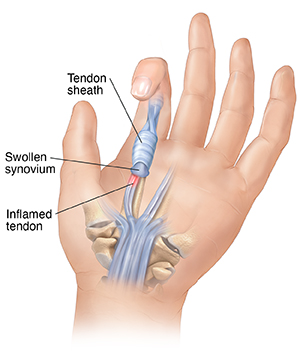Trigger finger is a condition that affects the tendons in your fingers or thumb. It can limit finger movement. When you try to straighten your finger, it may lock or catch before popping straight out.
Tendons are tissues that connect muscles to bone. When muscles contract, tendons pull on bones. This is what causes some parts of the body to move. The muscles that move the fingers and thumb are located in the forearm, above the wrist. Long tendons – called the flexor tendons – extend from the muscles through the wrist and attach to the small bones of the fingers and thumb. When you bend or straighten your finger, the flexor tendon slides through a snug tunnel, called the tendon sheath, which keeps the tendon in place next to the bones.

The flexor tendon can become irritated as it slides through the tendon sheath tunnel. As it becomes more and more irritated, the tendon may thicken and nodules may form, making its passage through the tunnel more difficult. The tendon sheath may also thicken, causing the opening of the tunnel to become smaller. If you have trigger finger, the tendon may become momentarily stuck at the mouth of the tendon sheath tunnel when you try to straighten your finger. You might feel a pop as the tendon slips through the tight area, and your finger will suddenly shoot straight out.
The cause of trigger finger is usually unknown. There are factors that put people at greater risk for developing it.
Symptoms of trigger finger usually start without injury, although they may follow a period of heavy hand use. One or more fingers may be affected. Symptoms may include:


Monday- Friday: 8:30AM- 5:00 PM
Saturday- Sunday: Closed